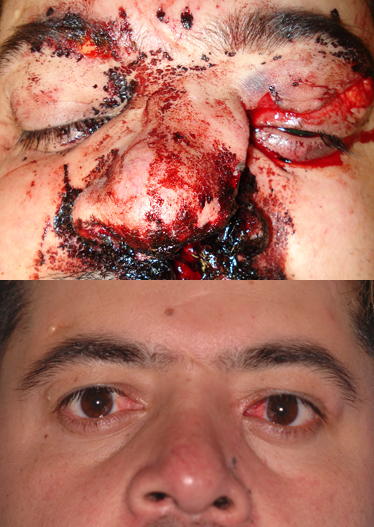[1]
Nguyen M,Koshy JC,Hollier LH Jr, Pearls of nasoorbitoethmoid trauma management. Seminars in plastic surgery. 2010 Nov;
[PubMed PMID: 22550462]
[2]
Murphy RX Jr,Birmingham KL,Okunski WJ,Wasser T, The influence of airbag and restraining devices on the patterns of facial trauma in motor vehicle collisions. Plastic and reconstructive surgery. 2000 Feb;
[PubMed PMID: 10697154]
[3]
Markowitz BL,Manson PN,Sargent L,Vander Kolk CA,Yaremchuk M,Glassman D,Crawley WA, Management of the medial canthal tendon in nasoethmoid orbital fractures: the importance of the central fragment in classification and treatment. Plastic and reconstructive surgery. 1991 May;
[PubMed PMID: 2017492]
[4]
Sargent LA, Nasoethmoid orbital fractures: diagnosis and treatment. Plastic and reconstructive surgery. 2007 Dec;
[PubMed PMID: 18090726]
[5]
Roden KS,Tong W,Surrusco M,Shockley WW,Van Aalst JA,Hultman CS, Changing characteristics of facial fractures treated at a regional, level 1 trauma center, from 2005 to 2010: an assessment of patient demographics, referral patterns, etiology of injury, anatomic location, and clinical outcomes. Annals of plastic surgery. 2012 May;
[PubMed PMID: 22531401]
Level 2 (mid-level) evidence
[6]
Kelley P,Crawford M,Higuera S,Hollier LH, Two hundred ninety-four consecutive facial fractures in an urban trauma center: lessons learned. Plastic and reconstructive surgery. 2005 Sep;
[PubMed PMID: 16141803]
[7]
Cabalag MS,Wasiak J,Andrew NE,Tang J,Kirby JC,Morgan DJ, Epidemiology and management of maxillofacial fractures in an Australian trauma centre. Journal of plastic, reconstructive
[PubMed PMID: 24200703]
[8]
Chapman VM,Fenton LZ,Gao D,Strain JD, Facial fractures in children: unique patterns of injury observed by computed tomography. Journal of computer assisted tomography. 2009 Jan-Feb;
[PubMed PMID: 19188788]
[9]
Nalliah RP,Allareddy V,Kim MK,Venugopalan SR,Gajendrareddy P,Allareddy V, Economics of facial fracture reductions in the United States over 12 months. Dental traumatology : official publication of International Association for Dental Traumatology. 2013 Apr;
[PubMed PMID: 22487364]
[10]
Wei JJ,Tang ZL,Liu L,Liao XJ,Yu YB,Jing W, The management of naso-orbital-ethmoid (NOE) fractures. Chinese journal of traumatology = Zhonghua chuang shang za zhi. 2015;
[PubMed PMID: 26777715]
[11]
Keenan HT,Brundage SI,Thompson DC,Maier RV,Rivara FP, Does the face protect the brain? A case-control study of traumatic brain injury and facial fractures. Archives of surgery (Chicago, Ill. : 1960). 1999 Jan;
[PubMed PMID: 9927123]
Level 2 (mid-level) evidence
[12]
Lee KF,Wagner LK,Lee YE,Suh JH,Lee SR, The impact-absorbing effects of facial fractures in closed-head injuries. An analysis of 210 patients. Journal of neurosurgery. 1987 Apr;
[PubMed PMID: 3559719]
[14]
Ghuman MS,Salunke P,Sahoo SK,Kaur S, Cerebral venous sinus thrombosis in closed head trauma: A call to look beyond fractures and hematomas! Journal of emergencies, trauma, and shock. 2016 Jan-Mar;
[PubMed PMID: 26957825]
[15]
Jose A,Nagori SA,Agarwal B,Bhutia O,Roychoudhury A, Management of maxillofacial trauma in emergency: An update of challenges and controversies. Journal of emergencies, trauma, and shock. 2016 Apr-Jun;
[PubMed PMID: 27162439]
[16]
Holt GR,Holt JE, Incidence of eye injuries in facial fractures: an analysis of 727 cases. Otolaryngology--head and neck surgery : official journal of American Academy of Otolaryngology-Head and Neck Surgery. 1983 Jun;
[PubMed PMID: 6410328]
Level 3 (low-level) evidence
[17]
Gruss JS,Hurwitz JJ,Nik NA,Kassel EE, The pattern and incidence of nasolacrimal injury in naso-orbital-ethmoid fractures: the role of delayed assessment and dacryocystorhinostomy. British journal of plastic surgery. 1985 Jan;
[PubMed PMID: 3967108]
[18]
Potter JK,Muzaffar AR,Ellis E,Rohrich RJ,Hackney FL, Aesthetic management of the nasal component of naso-orbital ethmoid fractures. Plastic and reconstructive surgery. 2006 Jan;
[PubMed PMID: 16404240]
[19]
Rosenberger E,Kriet JD,Humphrey C, Management of nasoethmoid fractures. Current opinion in otolaryngology
[PubMed PMID: 23770830]
Level 3 (low-level) evidence
[20]
Remmler D,Denny A,Gosain A,Subichin S, Role of three-dimensional computed tomography in the assessment of nasoorbitoethmoidal fractures. Annals of plastic surgery. 2000 May;
[PubMed PMID: 10805308]
[21]
Ellis E 3rd, Sequencing treatment for naso-orbito-ethmoid fractures. Journal of oral and maxillofacial surgery : official journal of the American Association of Oral and Maxillofacial Surgeons. 1993 May;
[PubMed PMID: 8478762]
[22]
Marão HF,Gulinelli JL,Pereira CC,Carvalho AC,Faria PE,Magro Filho O, Use of titanium mesh for reconstruction of extensive defects in fronto-orbito-ethmoidal fracture. The Journal of craniofacial surgery. 2010 May;
[PubMed PMID: 20485040]
[24]
Baliga SD,Urolagin SB, Transnasal Fixation of NOE Fracture: Minimally Invasive Approach. Journal of maxillofacial and oral surgery. 2012 Mar;
[PubMed PMID: 23449153]
[25]
Becelli R, Renzi G, Mannino G, Cerulli G, Iannetti G. Posttraumatic obstruction of lacrimal pathways: a retrospective analysis of 58 consecutive naso-orbitoethmoid fractures. The Journal of craniofacial surgery. 2004 Jan:15(1):29-33
[PubMed PMID: 14704558]
Level 2 (mid-level) evidence
[29]
Herford AS,Ying T,Brown B, Outcomes of severely comminuted (type III) nasoorbitoethmoid fractures. Journal of oral and maxillofacial surgery : official journal of the American Association of Oral and Maxillofacial Surgeons. 2005 Sep;
[PubMed PMID: 16122589]
[30]
Morris LM,Kellman RM, Complications in facial trauma. Facial plastic surgery clinics of North America. 2013 Nov;
[PubMed PMID: 24200379]
[33]
Girotto JA,MacKenzie E,Fowler C,Redett R,Robertson B,Manson PN, Long-term physical impairment and functional outcomes after complex facial fractures. Plastic and reconstructive surgery. 2001 Aug;
[PubMed PMID: 11496168]

